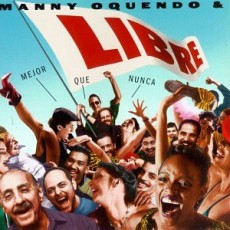
Daily Dose Of Jazz…
Francisco “Chino” Pozo was born on October 4, 1915 in Havana, Cuba. An autodidact on piano and bass, he concentrated on bongos, congas, and drums before leaving his home for greener pastures. Moving to the United States in 1937, he played with Machito from 1941–43 and with the Jack Cole Dancers from 1943-1949.
In the Fifties he went on to play in numerous jazz ensembles, especially latin jazz and Afro-Cuban jazz. He performed and/or recorded with Jose Curbelo, Noro Morales, Tito Puente, Tito Rodríguez, Enric Madriguera, Perez Prado, Josephine Premice, Tadd Dameron, Charlie Parker, and Dizzy Gillespie.
He toured with Peggy Lee in 1954-55 and played with Stan Kenton in 1955, Herbie Mann in 1956, Xavier Cugat and René Touzet in 1959.
He also recorded with Illinois Jacquet, Phineas Newborn, Gábor Szabó, Paul Anka, Justo Betancourt, Harry Betts, Fats Navarro, Eddie Palmieri, Johnny Richards, A. K. Salim, Billy Taylor, Clark Terry, Chico O’Farrill, Julius Watkins and Charlie Rouse.
Drummer Chino Pozo, whose claim to be the cousin of Chano Pozo has been disputed, died on April 28, 1980 in New York City.
More Posts: bass,bongo,conga,drums,history,instrumental,jazz,music,piano

Daily Dose Of Jazz…
Armando Peraza was born May 30, 1924 in Lawton Batista, Havana, Cuba and was orphaned by age 7 and lived on the streets. By twelve he was supporting himself by selling vegetables, coaching boxing, playing semi-pro baseball, and becoming a loan shark. His music career began at seventeen when he heard at a baseball game that bandleader Alberto Ruiz was looking for a conga player and Ruiz’s brother was on the same baseball team as him. Despite the absence of experience in music, he practiced and won the audition.
He left Cuba for Mexico in 1948 to tend to his sick friend, conga drummer Mongo Santamaría. They arrived in New York City in 1949 and after playing in Machito’s big band, Peraza was invited by Charlie Parker to participate in a recording session that included Buddy Rich. He recorded with Slim Gaillard in New York Cuty in 1949 in a session that produced Bongo City and toured the U.S. with him band until they reached San Francisco, California. He spent time in Mexico recording with Perez Prado and did some soundtracks for the Mexican movie industry.
Returning to the U.S. he settled in San Francisco, worked with Dizzy Gillespie, toured extensively with Charles Mingus and Dexter Gordon, and played with Puerto Rican actor and musician Tony Martinez. Armando led an Afro-Cuban dance review at the Cable Car Village Club in San Francisco, attracting a clientele from Hollywood that included Errol Flynn, Marlon Brando, and Rita Hayworth.
By 1954, he was working with pianist Dave Brubeck, Peraza met Cal Tjader, and jazz critic Leonard Feather recommended Peraza to Fantasy Records to record an Afro-Cuban album with Tjader. The result was Ritmo Caliente, which combined Afro-Cuban rhythms with a jazz sensibility. Following this he met George Shearing through bassist Al McKibbon and he spent the next twelve years with the pianist, a collaboration that put Peraza at the forefront of Afro-Cuban music.
Armando emerged as a composer, writing and recording twenty-one songs for Shearing, such as Mambo in Chimes, Mambo in Miami, Ritmo Africano, Armando’s Hideaway, This is Africa, and Estampa Cubana. These recordings were during the mambo craze in the U.S. and the world. In 1959, he joined Mongo Santamaría for the Mongo album, then became a member of Cal Tjader’s band for six years, followed by a stint with drummer Shelly Manne.
He recorded one solo album, Wild Thing, was the first Afro-Cuban percussionist to add conga drums to a rock track, an in 1972, at the age of 47, Peraza joined the rock band Santana, influencing andtrmining for nearly twenty years and played to millions of people around the world, partnering with percussionists José Areas, Mingo Lewis, Raul Rekow, and Orestes Vilató. He wrote or co-wrote sixteen songs recorded by Santana.
Peraza retired from Santana in 1990 at the age of 66, played a Santiago de Chile concert with Santana in 1992, returned to Cuba after fifty year absence in 202, and recorded on the John Santos, 20th Anniversary in 2005, At 82 years of age, in 2006 he made a rare appearance with Santana for a three show performance at the Montreux Jazz Festival in Switzerland. In 2007, he received a Lifetime Achievement Award from the Voices of Latin Rock, who present the Armando Peraza Award for achievement in the San Francisco Bay Area every year.
On April 14, 2014 Latin jazz percussionist Armando Peraza who played congas, bongos, and timbales transitioned from complications of pneumonia. He was 89.
More Posts: bongo,conga,history,instrumental,jazz,music,timbales

Daily Dose Of Jazz…
Manny Oquendo was born on January 1, 1931 in New York City of Puerto Rican ancestry. Growing up he began studying percussion in 1945 and went on to work in the tropical bands and Latin music ensembles like Carlos Valero, Luis del Campo, Juan “El Boy” Torres, Chano Pozo, Jose Budet, Juanito Sanabria, Marcelino Guerra, Jose Curbelo and Pupi Campo.
In 1950, he became the bongo player for Tito Puente followed by Tito Rodriguez four years later. He moved on to Vicentico Valdes the next year and freelanced in the City before joining Eddie Palmieri’s Conjunto La Perfecta in 1962, where he helped develop the New York style of the mozambique rhythm.
Manny co-led Conjunto Libre with bassist Andy González from 1974 and had a worldwide hit with the Freddie Hubbard composition Little Sunflower in 1983 on the album Ritmo, Sonido y Estilo. He also was a sideman with Paul Quinichette.
His timbales solos were famous for their tastefully sparse, straight forward “típico” phrasing and his solos also incorporated the rhythmic language of the folkloric quinto, the lead drum ofrumba. Percussionist Manny Oquendo, who also played bongos, timbales, and left a small catalogue of nine albums as a leader, passed away on March 25, 2009.




